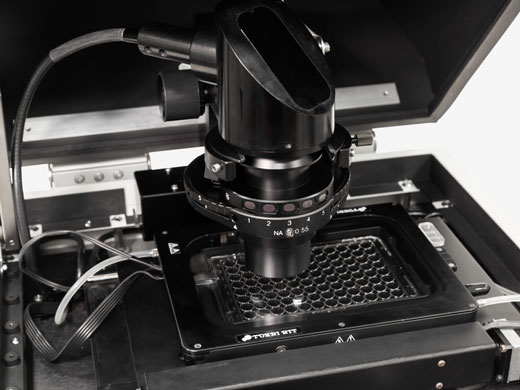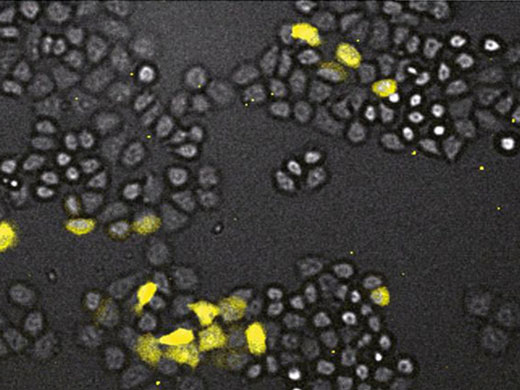对不起,此内容在您的国家不适用。
概述
 | A Quantum Leap in Live Cell ImagingThe LV200 has been carefully designed for long-duration cell bioluminescence. A completely new optical design dramatically increases sensitivity and enables the detailed study of photosensitive cells and luminescence probes at high magnification. The built-in system for temperature control, humidity and gas flow helps to keep the cultured cells or tissue slices in a healthy condition throughout the observation period and the unique light-tight enclosure shields the sample and optics from any external light. |
|---|
Cell-friendly ImagingLuminescence comes from within the sample and is in turn non-toxic to the cells. There is also no background noise or autofluorescence to worry about. Luminescence is, therefore, the right light for live cell imaging. |
Advanced Bioluminescence MicroscopyLuminescence has several potential benefits over fluorescence including better signal-to-background ratios due to the lack of background emission and no phototoxicity nor photobleaching, making it ideal for quantitatively following long-term changes in live cell systems. The observation of luminescence has previously been held back by a number of technical challenges. In the LUMINOVIEW LV200, Olympus has successfully developed a luminescence microscope system that overcomes these challenges and harnesses the power of bioluminescence imaging for the first time in a commercial system. |
Overcoming the Limitations of FluorescenceFluorescence microscope and related techniques have many advantages, but also a number of limitations. Bioluminescence imaging has the potential to overcome these limitations. The unique optical design of the new Olympus LV200 brings together the advantages of fluorescence and bioluminescence to create a system capable of acquiring bright, high- resolution images. |
|
FluorescenceFluorescent emissions tend to be short-lived and bright, requiring specific frequencies of light for excitation. As a result, this illumination is required at the time of imaging, which means that the optical system must be able to supply strong and fully controllable light at one wavelength and project the emitted light on a different wavelength to the user’s eyes and/or camera. Despite these relatively complex optical requirements, fluorescence techniques have flourished and are enabling groundbreaking discoveries in many research areas. |
Bioluminescence ImagingLuminescence emissions tend to have varying lifetimes and are often quite faint, but due to the lack of background or fluorescence they can be measured with a high signal-to-noise (S/N) ratio. This makes luminescence ideal for applications where there is strong autofluorescence, such as whole animal imaging or in samples containing various compounds from chemical libraries. The in vivo imaging systems and microplate luminescence readers have shown great success in these areas. |
High Signal/Noise Ratio without Bleaching/ToxicityBioluminescence imaging has great advantages over fluorescence imaging since it combines a high S/N ratio with no bleaching/phototoxic effects. What is more, only viable cells emit luminescence signals since emission is only possible with a functioning metabolism. As a result of this, bioluminescent measurements are ideal for sensitive living cells and are absolute and directly quantitative. These advantages are now no longer limited to macro imaging and bulk measurement, but can now also be applied to high-resolution microscopy. |
High-quality ImagesOlympus has developed the LV200 LUMINOVIEW bioluminescent imaging system, which provides amazingly detailed images using standard CCDs rather than specialized photon detectors. To do this, the optical design of the system is highly specialized to maximize light collection - an essential aspect, given the low levels of light emitted. |
An Optimized Light PathThe light path from the object to the camera is straight and as short as it can be to ensure that as much light as possible reaches the CCD chip. There is also no need for any additional mirrors, filters or lenses which absorb light, reducing the signal even further. Furthermore, the tube lens has been designed with an extremely high numerical aperture (NA), which affords a vast increase in sensitivity when compared to conventional microscope optics. As a result, the LV200 produces signal outputs many times higher than traditional systems and can, therefore, be used with conventional CCD or EM-CCD cameras. The LV200 can use different magnifications from 0.8x to 20x, enabling it to clearly image samples from large brain sections down to individual cells. |
| Higher Resolution ImagingThese unique optical properties ensure exquisite single-cell resolution not previously possible with luminescence imaging. These improvements, along with the number of luminescent probes now available, promise to take microscope imaging to a different level. These properties also enable excellent spatial resolution, so that weak signals near areas with high signals can be differentiated with great ease, which is not possible on a luminometer. |
|---|
Use in Normal Lab EnvironmentThe light-tight enclosure of the LV200 shields the samples and optics from external light and allows the microscope to be used under ambient light in the laboratory. For applications or samples that require very long exposure times, the microscope might have to be moved to a low-light room. |
Expanding Current Imaging CapabilitiesWith optical components optimized for the detection of luminescent light, the LV200 is further designed to match the requirements of a broad range of research. It has integrated excitation and emission filter wheels to enable dual-color luminescence as well as transmitted light fluorescence imaging. With standard brightfield illumination and phase contrast inserts, target areas of the sample can be found easily before switching to luminescence detection. It is, therefore, also possible to produce luminescent and fluorescent overlays on brightfield images, which enables localization and colocalization capabilities that were not previously possible. |
|
| IncubatedWith the system now capable of long-term imaging, it is important that samples can be left on the stage for the entire time of the imaging experiment. The LV200 is designed so that samples can be placed inside a highly accurate environmental chamber, which has independent temperature control for the stage, incubation chamber, top cover and objective. Furthermore, a water reservoir is used to maintain the correct humidity level, and CO2 flow control enables pH stability. Such environmental control enables samples to be continuously monitored over days or even weeks, without the need to move the sample between the microscope and an incubator. |
|---|
Need assistance? |
技术规格
| Observation Methods | Luminescence imaging, transmitted brightfield, basic transmitted fluorescence |
|---|---|
| LV200 Main Body | Light-tight dark box |
| Manual objective lens focusing | |
| Coaxial XY stage | |
| Motorized exciting filter wheel with 3 positions for standard 25 mm optical filters | |
| Motorized emission filter wheel with 6 positions for standard 25 mm optical filters | |
| Condenser for transmission brightfield coupled to light guide | |
| C-mount for camera | |
| Tube lens optimized for luminescence imaging, 0.2 X magnification | |
| Illumination Unit | External halogen lamp housing coupled with light guide |
| Controller | IX-UCB controller for filter wheels and illumination |
| Hand Switch | Hand switch for filter wheels and illumination |
| Environmental Control | Double-layered chamber type incubator for 35 mm dish including controller, stage heater, top cover heater, |
| main body heater, objective heater, flow meter for 5 % CO2, 95 % air | |
| System Table | Approx. 600 (W) x 600 (D) mm x 700 (H) (needed if large-size camera is used) |
| Camera Options | Depending on application and required sensitivity, cooled CCD cameras, EM-CCD cameras or deep-cooled slow-scan |
| CCD cameras can be used. (Please ask about camera/software compatibility.) | |
| Power Consumption | Main unit 850 VA |
| Controller 840 VA | |
| Installation Space | Approx. 1500 (W) x 750 (D) mm (depending on configuration) |
| Total Mass Weight | Approx. 70 kg (depending on configuration) |
Recommended Objectives |
| NA | WD (mm) | Correction (mm) | |
|---|---|---|---|
| UPLSAPO 10X | 0.4 | 3.1 | 0.17 |
| UPLSAPO 20X | 0.75 | 0.6 | 0.17 |
| UPLSAPO 40X | 0.9 | 0.18 | 0.11 - 0.23 |
| UPLSAPO 60XO | 1.35 | 0.15 | 0.17 |
| UPLSAPO 100XOI | 1.4 | 0.13 | 0.17 |
| LUCPFLN 20X | 0.45 | 6.6 - 7.8 | 0 - 2 |
| LUCPFLN 40X | 0.6 | 2.7 - 4 | 0 - 2 |
| PLAPON 60XO | 1.42 | 0.15 | 0.17 |
应用
HeLa cells using GL3 luciferase
| NIH/3T3 cell
|
Mouse NIH3T3 fibroblasts
| Luciferase, GFP and brightfield
|
HeLa cells
| CHO cells
|
Bilateral SCN
| LUC luciferase
|
LUC luciferase
|
DBP luciferase Related Videos | Gadi bmalluc transient Related Videos |






















